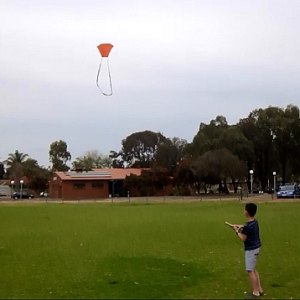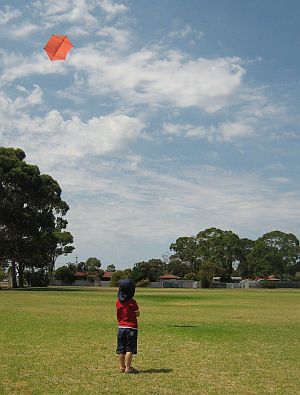- Home Page
- How To Fly
- Go Fly a Kite
Go Fly a Kite!
OK OK OK (But it's Actually a Good Idea)
Go fly a kite! Who hasn't heard of this expression, meaning "I'm just not interested, please go away"—or words far less polite.
 MBK 2-Skewer Barn Door
MBK 2-Skewer Barn DoorIn fact, there's an RC Kite company in Singapore with the name GoFlyKite. That's what one businessman said to another, during a disagreement that resulted in the creation of the company. Believe it or not.
A visitor to this site has offered some more insight, noting that he has seen the expression pop up in several different cultures and languages. For example, in his own country, the Italian phrase is vai a far correre l'aquilone! which means go run the kite! The saying is at least several decades old, since it has been in use by a few generations now. Wouldn't you agree?
What if I told you this entire page takes a bit of a weird angle, exploring the actual reasons you might want to get out and fly a tethered craft. Would you tell me to go fly a kite? ;-) Follow that link for some more straightforward analysis and illustration of the term.
A bit of a drive down memory lane has brought a whole lot of experiences to mind, which will help to illustrate some reasons for getting out to fly. Check them out, further down this page.
On this site, there's more kite-making info than you can poke a stick at. :-)
Want to know the most convenient way of using it all?
The Big MBK E-book Bundle is a collection of downloads—printable PDF files which provide step-by-step instructions for many kites large and small.
Every kite in every MBK series.
I Just Made One!
Probably, the most compelling reason to go fly a kite is
because you just made one!
With practice and experience, new kites nearly always fly well on their first outing. I never got sick of putting up a new design straight to 300 feet on the very first flight, weather permitting. It was a good feeling when it happened!
Apart from just a few outings with a sport kite, my experience is entirely with single liners and mainly homemade ones at that.
It Plays on the Senses
That is, except for the sense of smell, unless you count the subtle smells of the outdoors—the grass, leaves, insects, and so forth. When I go fly a kite, I never seem to notice. But it's the other senses that combine to really make the kite come alive for the flier. It's not just a kite. It's a kiting experience, and it can really uummm lift you.
 MBK 1-Skewer Roller
MBK 1-Skewer Roller- Sights. This is the most obvious, from a glowing backlit sail or striking colorful design, to the characteristic motions every kite has. For example, there are tip-wagging diamonds, small weaving sodes, gracefully floating deltas, bending rokkakus, steady barn doors, and the list could go on.
- Sounds. These include flapping trailing edges in a fresh breeze, rustling tail plastic as the kite is lowered at the end of the day, and whistles and downright strange noises from the flying line as the wind speed picks up. All these are pretty subtle most of the time when you're out to fly a kite. But just occasionally it comes to your attention and triggers a feeling. It's faintly positive, I guess; there's not a lot of exhilaration in the sound of gently moving plastic! But it's like there's a living thing up there, saying "Hey, I'm here!"
- Vibrations, pulses, and strains. On reflecting about all the different sensations that can come down the line, there are actually quite a few. It all depends on the kite and the wind strength. Even the gustiness of the wind plays a role, since smaller kites can sometimes feel like a fish on the end of a fishing line. The direct force of the wind on the sail is one thing, but I think that other aerodynamic effects can also contribute to the pulses on the line. For example, tip stalls and flutter. Bigger kites tend to just raise and lower the tension in the line more gently. However, they can also pull the line very tight, making it sing at various frequencies as the wind causes vibration!
Just as an aside, it seems that the various major categories of kites tend to attract distinct personality types. Would you like some examples? Just three might illustrate the point:
- Traction kites attract sporty, adventurous types who traverse all sorts of terrain. These are kite-powered extreme-sports people!
- Sport kites tend to be flown by competitive types who try to improve their own precision flying or beat others in competition.
- Single liners are often flown by laid-back fliers who appreciate solitude—like Your's Truly. They tend to have quite a deep connection with the wonder and experience of flight.
Love the Great Indoors?
Go Fly a Kite!
Who hasn't heard of the time-honored remedy of "getting out of the house for a while"? It's not an issue for some who don't actually spend much time inside their own homes, but we're talking introverted kite-fanciers here. :-)
A good long kite-flying session is good for removing various pressures from your mind. It gives you a break!
Spend some time out in the sun, protected by a wide-brimmed or flapped hat, of course. The sunlight ups your Vitamin D levels, brightens your mood, and now I feel some verse coming on:
Experience the weather, even measure it,
With windsocks and bubbles lifting and swirling.
Anemometers and gauges whirring—
Flight-enhancing toys for the single-liner nut!
OK, that last line's a half-rhyme with the first line; don't you know anything about poetry? ;-)
Quality Family Time
It's good to have, particularly with small sons and daughters! Go fly a kite with them. My son Aren has been involved with my kite flying since the age of about two years. Much of his early kite flying was conducted from a seated position in his pram! The photo shows him a few years later with one of our bamboo-and-plastic roks.
 MBK 2-Skewer Rokkaku
MBK 2-Skewer RokkakuI'll just list off a few things now, that Aren did:
- Age 2: Held up a small kite and watched its tail flutter in the breeze. Tossed the reel after grasping it for a few seconds. Spotted the kite in the air and looked at it for a few seconds.
- Age 3: Ran along, towing a small diamond kite. Chased after its tail while it was brought down. Hung on to the flying line for a minute or two and slowly pulled it in, hand over hand.
- Age 4: Took an interest in going out to fly. Took an interest in how the kite was rigged. Happy to fly a bigger kite for a while in light winds. Jerked the line repeatedly to see how the kite reacted—before he got told to stop it immediately!
There's just a small sample of how kids graduate through stages in their kite flying.
Of course, kids need other things to do as well, since their attention span can be limited. Meanwhile, you get to continue to fly the kite. Usually, you can tether it somewhere. Hence you can spend time with the youngster while keeping half an eye on the sky!
Noticing People's Reactions
Although the main focus when deciding to go fly a kite or three is the flying, you can't help but notice people's reactions. It nearly always makes you feel something. Either about the kite itself or the flying experience that is unfolding. And it's usually a positive thing! Now, here's a short catalog of people's reactions from past flying outings:
- A departing car toots as they gawk at the 2-Skewer Barn Door surging around at 200 feet on a rather warm and gusty day. Hey, someone else is getting something from seeing the kite up there! Perhaps they will go fly a kite later on as a result.
- I catch sight of a man craning his neck to watch the tiny 1-Skewer Sode weaving away in a brisk breeze on 300 feet of line. Although it was weaving, it was basically holding position. The guy was there for several minutes! It was amusing that such a small cheap kite could hold his attention like that.
- Here's a slightly funny one. A lady comes across the field, walking her dog. She takes just a quick glance at the strange guy staring up into the sky with his hand in front of him. She disappears from view, none the wiser. Meanwhile, I was getting a real kick out of seeing and feeling the 2-Skewer Rokkaku overhead at 400 feet, meandering around in patches of rising air. At that height, even if she did look up, the kite would have been hard to spot!
- And slightly funnier perhaps—I'm having trouble keeping a kite in the air due to the very fresh breeze pushing it past its limits. The kite loops and lands often. A guy comes up and asks, "not enough wind, mate?" You gotta be kidding.
- And, of course, you tend to lose count of the times you hear excited kids saying "look Mum, a kite!" Anyone getting excited by one of your own kites just sets off a brief feeling of pride, doesn't it. Plus it's nice to raise someone else's spirits in that way—even if they are only four years old. :-)
The Love of Flight
And I'll spare you the poetry this time. However, there is something poetic about the flight of your favorite delta or rok.
The love of flight spans many things in some of us kiters. Some might enjoy the full range of kite craft, from traction right through to indoor featherweights. Others focus steadily on one form or the other. Consider Ray Bethell, who only cared for stunt kites but took it to the nth degree—world records and all.
And that's only kites! Examine people's backgrounds and you will find airline pilots, glider pilots, aeromodelers, heck maybe even frisbee or boomerang throwers. Chances are, a kiter has flown something else in his or her lifetime.
In my case, that's just about everything without an engine, except balloons. And I'll have to fix that itch one day!
When these people go fly a kite, it tweaks something in their soul. It reawakens the mystery, the draw, of flight all over again. It's something that remains even after you have gained a solid grasp of the principles of flight. You might know all about it, but you never get sick of experiencing a flying object all the same!
"If it flies without an engine—even purer, even better!" That's just a thought.
Now, go fly a kite will you!
As mentioned earlier, there's more kite making on this site than you can poke a stick at. :-)
Want to know the most convenient way of using it all?
The Big MBK E-book Bundle is a collection of downloads—printable PDF files that provide step-by-step instructions for many kites large and small.
That's every kite in every MBK series.
